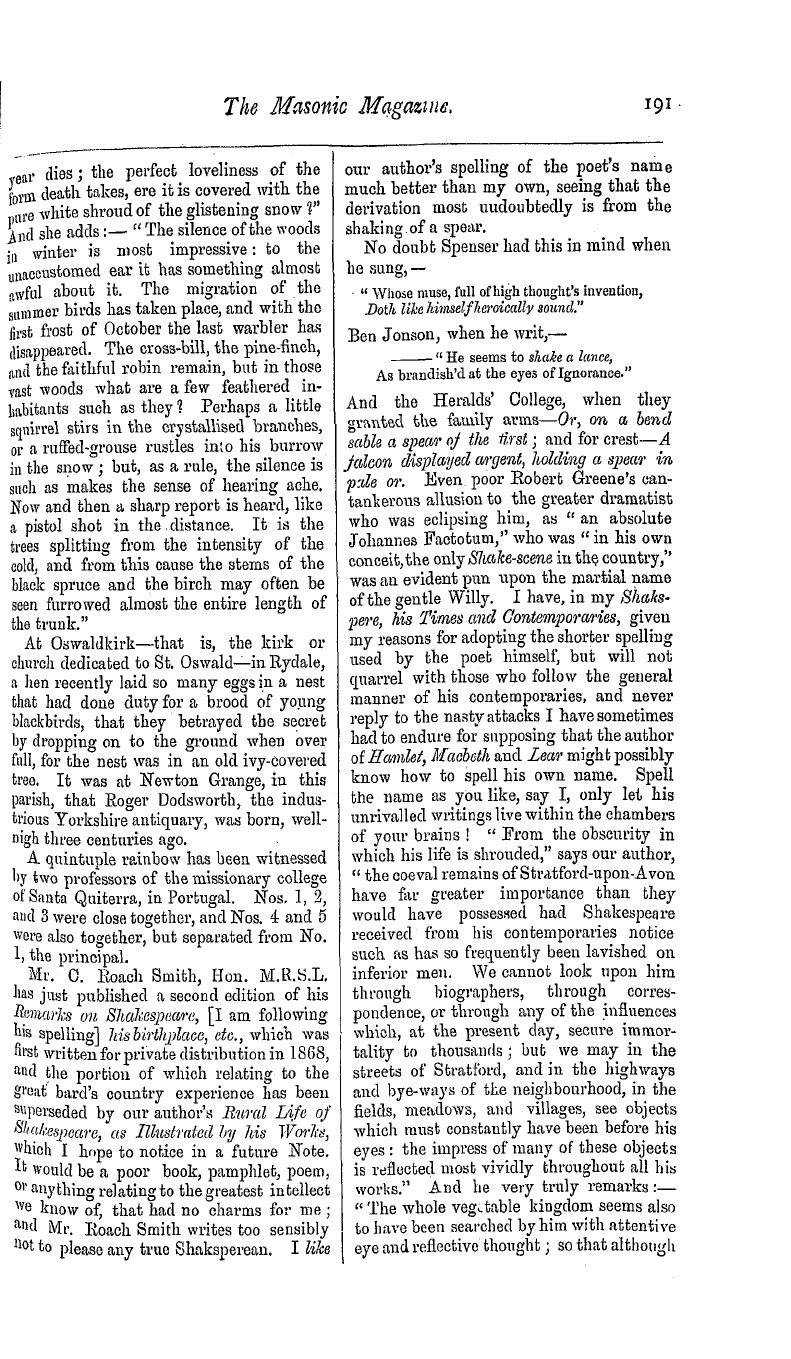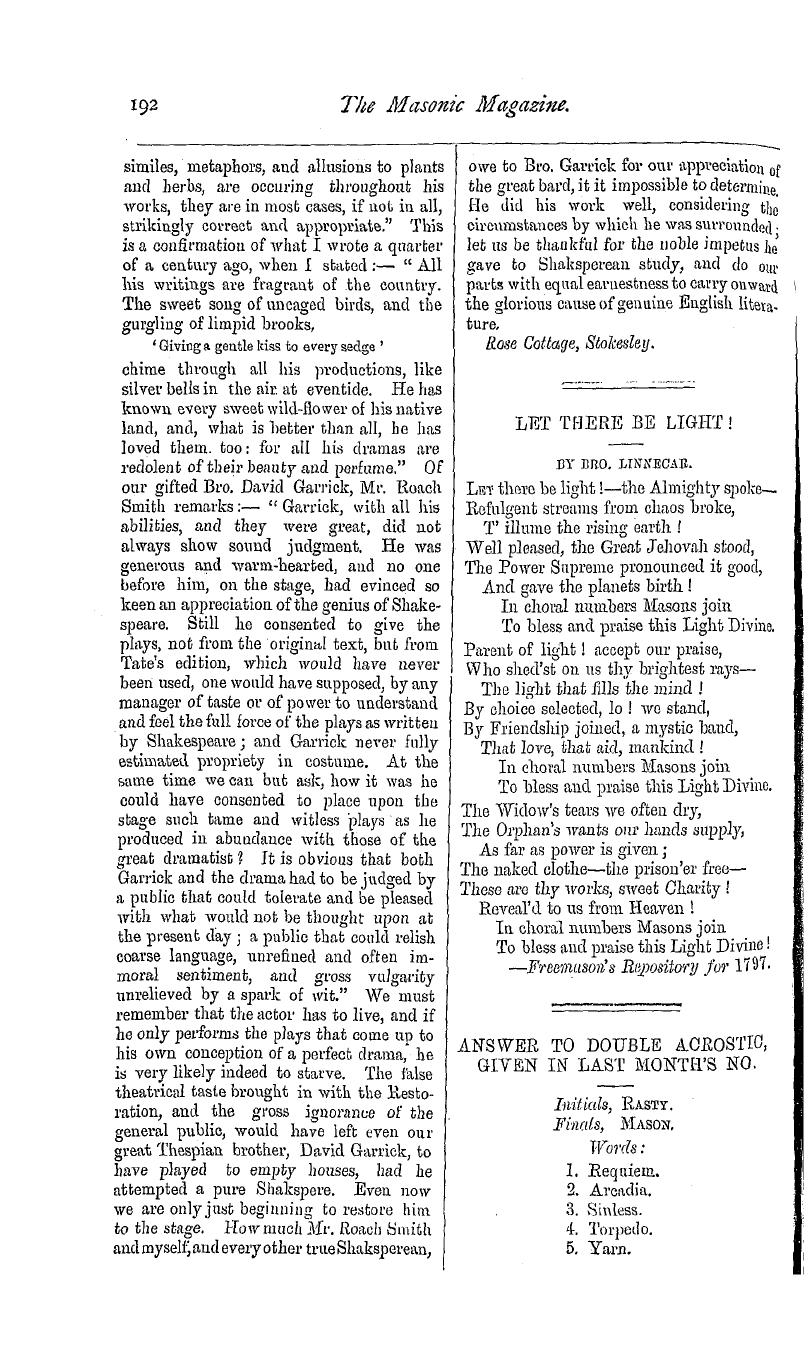-
Articles/Ads
Article THE WORK OF NATURE IN THE MONTHS. ← Page 4 of 5 →
Note: This text has been automatically extracted via Optical Character Recognition (OCR) software.
The Work Of Nature In The Months.
the Spindle Tree : there are , perhaps , no more beautiful objects in nature than the waxen clusters of berries borne by this group of shrubs . From fruit-bearing shrubs we pass to nut-bearing trees like the Chestnut , the Beechand the Oak . Many eat the fruit
, of the first ; a few that of the second ; none , unless compelled by famine or the most inscrutable and insatiable appetite of the genus " boy , " that of the last . But it was not always so , at least if we are to believe the historians who assure us that
our ancestors delighted in Acorns . "If so , all that we can say is that either our taste has sadly altered , or that we have lost one great secret of the culinary art , which , if they could recover it for us , ought to make the fortune , in these days of dear food , of the Masters of the Schools of Cookery .
As this consummation of culinary research does not seem very likely to be reached , we must just notice a field wherein our food-supply really might , by dint of a little research , be very considerably enrichedwe mean that of the Fungus
, tribe , which at this season is generally very prolific . Not to mention the gourmand ' s Truffle , or even the much esteemed Mushroom , there is many a similar plant which might be , nay is , at all events on the Continentturned into a dish no less
appe-, tising than nutritious . In the market of Rome alone , from which , by the way , our own , and almost only , Mushroom is rigorously excluded , the annual value of the Fungi sold for food is said to be about four thousand pounds . Once more then
whilst counselling the increased use of these esculents as an addition as agreeable as economical to our tables , let us give a word of warning as to the care requisite to exclude those kinds which are unwholesome .
For this purpose many so-called rules have been promulgated , all probably equally worthless ; we mean the discolouration of silver by the poisonous kinds , the difference of colour when cut , and the like . In reality there seems to be no other exact guide than an actual knowledge of the properties of
the various kinds , although we have found one test , and that a simple one , very valuable—most of the wholesome kinds if sprinkled with salt will turn black . The difficulty of framing any reliable law is enhanced from the curious fact that the
properties of the various kind vary witi , the differences of climate and other circus , stances of growth ; the effect , too , of pte cisely the same kind is variable even in the same person . So too are the poisonous effects variable , being sometimes irritant and sometimes narcotic ; these opposite
effects having been produced in members of the same family by the same dish of so . called Mushrooms . Fatal results are very rare , especially when remedies are promptl y administered ; of such remedies the best arc Emetics and Castor Oil . So peculiar in their
growth and habits , at one time borderino upon tlie seaweed tribe from flourishing in watery liquids , at another approaching very closely to the lichens in their parasitic growth ; on the one hand , again , demons , trating their vegetable ori g in by drawing
their nourishment exclusively from that in which , ( and not to which , ) their root is fixed , and not from their surroundings ; and yet , at the same time , on the other hand , going far to give the lie to this imputed connexion , not only by the vast amount of Nitrogen contained in their tissues , but also by their actually taking in Oxygen and giving out Carbonic Acid , a
property belonging of right to the animal world ; that some naturalists have wellnigh determined to accord them a kingdom of their own . This half-link as it were between the great systems of Nature , bids us next cast our gaze on a few denizens of the air which
yet brave the cold and still sport amongst the shrubs and trees that we have been noticing . Amongst the Butterflies we shall still see a few of the latest bred Admirals and Peacocks , for these frail creatures , although not able to face
exposure to rough weather , can yet bear the cold ; the Queen of Spain Fritillary still flits about on sunny days , with a few of the rare Hair-Streaks , and in the neighbourhood of Dover may be found the beautiful Clouded Yellow Butterfly or Edusa .
Amongst the Moths are noticeable the Feathered Thorn , the Dotted Chestnut , the Autumn Green Carpet , the Pearly Underwing , the Turnip , and two species of the Quaker Moth—the red and the yello w line—mostly found in the Ivy and the Yew . Of the Birds that leave us are the Landrail , Waterrail , Redstart , Hobby , Redshank , and Sandpiper ; whilst to take their
Note: This text has been automatically extracted via Optical Character Recognition (OCR) software.
The Work Of Nature In The Months.
the Spindle Tree : there are , perhaps , no more beautiful objects in nature than the waxen clusters of berries borne by this group of shrubs . From fruit-bearing shrubs we pass to nut-bearing trees like the Chestnut , the Beechand the Oak . Many eat the fruit
, of the first ; a few that of the second ; none , unless compelled by famine or the most inscrutable and insatiable appetite of the genus " boy , " that of the last . But it was not always so , at least if we are to believe the historians who assure us that
our ancestors delighted in Acorns . "If so , all that we can say is that either our taste has sadly altered , or that we have lost one great secret of the culinary art , which , if they could recover it for us , ought to make the fortune , in these days of dear food , of the Masters of the Schools of Cookery .
As this consummation of culinary research does not seem very likely to be reached , we must just notice a field wherein our food-supply really might , by dint of a little research , be very considerably enrichedwe mean that of the Fungus
, tribe , which at this season is generally very prolific . Not to mention the gourmand ' s Truffle , or even the much esteemed Mushroom , there is many a similar plant which might be , nay is , at all events on the Continentturned into a dish no less
appe-, tising than nutritious . In the market of Rome alone , from which , by the way , our own , and almost only , Mushroom is rigorously excluded , the annual value of the Fungi sold for food is said to be about four thousand pounds . Once more then
whilst counselling the increased use of these esculents as an addition as agreeable as economical to our tables , let us give a word of warning as to the care requisite to exclude those kinds which are unwholesome .
For this purpose many so-called rules have been promulgated , all probably equally worthless ; we mean the discolouration of silver by the poisonous kinds , the difference of colour when cut , and the like . In reality there seems to be no other exact guide than an actual knowledge of the properties of
the various kinds , although we have found one test , and that a simple one , very valuable—most of the wholesome kinds if sprinkled with salt will turn black . The difficulty of framing any reliable law is enhanced from the curious fact that the
properties of the various kind vary witi , the differences of climate and other circus , stances of growth ; the effect , too , of pte cisely the same kind is variable even in the same person . So too are the poisonous effects variable , being sometimes irritant and sometimes narcotic ; these opposite
effects having been produced in members of the same family by the same dish of so . called Mushrooms . Fatal results are very rare , especially when remedies are promptl y administered ; of such remedies the best arc Emetics and Castor Oil . So peculiar in their
growth and habits , at one time borderino upon tlie seaweed tribe from flourishing in watery liquids , at another approaching very closely to the lichens in their parasitic growth ; on the one hand , again , demons , trating their vegetable ori g in by drawing
their nourishment exclusively from that in which , ( and not to which , ) their root is fixed , and not from their surroundings ; and yet , at the same time , on the other hand , going far to give the lie to this imputed connexion , not only by the vast amount of Nitrogen contained in their tissues , but also by their actually taking in Oxygen and giving out Carbonic Acid , a
property belonging of right to the animal world ; that some naturalists have wellnigh determined to accord them a kingdom of their own . This half-link as it were between the great systems of Nature , bids us next cast our gaze on a few denizens of the air which
yet brave the cold and still sport amongst the shrubs and trees that we have been noticing . Amongst the Butterflies we shall still see a few of the latest bred Admirals and Peacocks , for these frail creatures , although not able to face
exposure to rough weather , can yet bear the cold ; the Queen of Spain Fritillary still flits about on sunny days , with a few of the rare Hair-Streaks , and in the neighbourhood of Dover may be found the beautiful Clouded Yellow Butterfly or Edusa .
Amongst the Moths are noticeable the Feathered Thorn , the Dotted Chestnut , the Autumn Green Carpet , the Pearly Underwing , the Turnip , and two species of the Quaker Moth—the red and the yello w line—mostly found in the Ivy and the Yew . Of the Birds that leave us are the Landrail , Waterrail , Redstart , Hobby , Redshank , and Sandpiper ; whilst to take their
















































